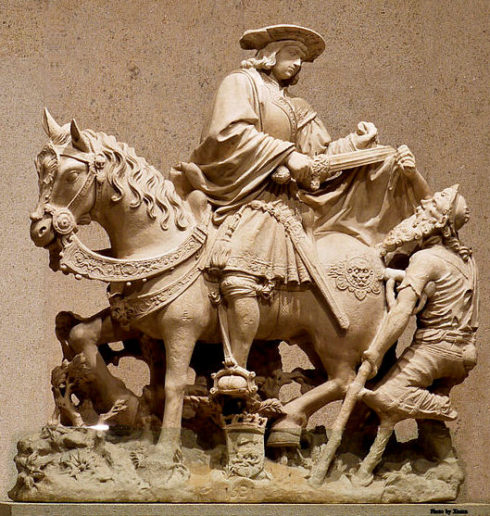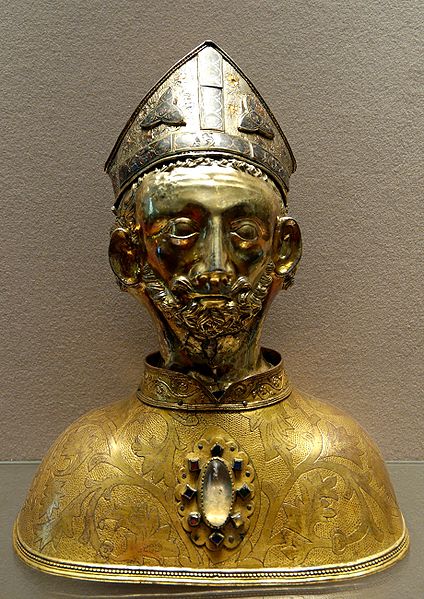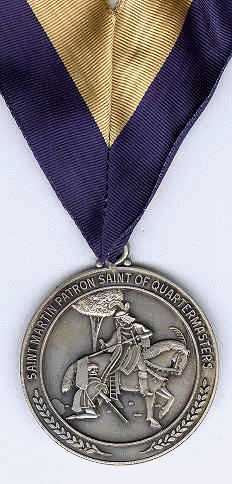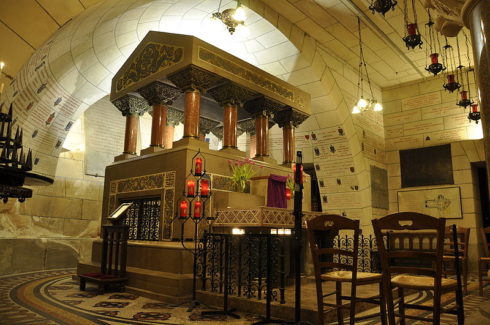St. Martin of Tours
Bishop; born at Sabaria (today Steinamanger in German, or Szombathely in Hungarian), Pannonia (Hungary), about 316; died at Candes, Touraine, most probably in 397.

Museum Calouste Gulbenkian, Lisbon, Portugal. Saint Martin on horseback sharing his cloak with a begger. France, Loire Valley, 1531. Limestone.
In his early years, when his father, a military tribune, was transferred to Pavia in Italy, Martin accompanied him thither, and when he reached adolescence was, in accordance with the recruiting laws, enrolled in the Roman army. Touched by grace at an early age, he was from the first attracted towards Christianity, which had been in favor in the military camps since the conversion of Emperor Constantine.
His regiment was soon sent to Amiens in Gaul, and this town became the scene of the celebrated legend of the cloak. At the gates of the city, one very cold day, Martin met a shivering and half-naked beggar. Moved with compassion, he divided his coat into two parts and gave one to the poor man. The part kept by himself became the famous relic preserved in the oratory of the Frankish kings under the name of “St. Martin’s cloak”.
Martin, who was still only a catechumen, soon received baptism, and was a little later finally freed from military service at Worms on the Rhine. As soon as he was free, he hastened to set out to Poitiers to enroll himself among the disciples of St. Hilary, the wise and pious bishop whose reputation as a theologian was already passing beyond the frontiers of Gaul. Desiring, however, to see his parents again, he returned to Lombardy across the Alps. The inhabitants of this region,  infested with Arianism, were bitterly hostile towards Catholicism, so that Martin, who did not conceal his faith, was very badly treated by order of Bishop Auxentius of Milan, the leader of the heretical sect in Italy. Martin was very desirous of returning to Gaul, but, learning that the Arians troubled that country also and had even succeeded in exiling Hilary to the Orient, he decided to seek shelter on the island of Gallinaria (now Isola d’Albenga) in the middle of the Tyrrhenian Sea.
infested with Arianism, were bitterly hostile towards Catholicism, so that Martin, who did not conceal his faith, was very badly treated by order of Bishop Auxentius of Milan, the leader of the heretical sect in Italy. Martin was very desirous of returning to Gaul, but, learning that the Arians troubled that country also and had even succeeded in exiling Hilary to the Orient, he decided to seek shelter on the island of Gallinaria (now Isola d’Albenga) in the middle of the Tyrrhenian Sea.
As soon as Martin learned that an imperial decree had authorized Hilary to return to Gaul, he hastened to the side of his chosen master at Poitiers in 361, and obtained permission from him to embrace at some distance from there in a deserted region (now called Ligugé) the solitary life that he had adopted in Gallinaria. His example was soon followed, and a great number of monks gathered around him. Thus was formed in this Gallic Thebaid a real laura, from which later developed the celebrated Benedictine Abbey of Ligugé. Martin remained about ten years in this solitude, but often left it to preach the Gospel in the central and western parts of Gaul, where the rural inhabitants were still plunged in the darkness of idolatry and given up to all sorts of gross superstitions. The memory of these apostolic journeyings survives to our day in the numerous local legends of which Martin is the hero and which indicate roughly the routes that he followed.
When St. Lidorius, second Bishop of Tours, died in 371 or 372, the clergy of that city desired to replace him by the famous hermit of Ligugé. But, as Martin remained deaf to the prayers of the deputies who brought him this message, it was necessary to resort to a ruse to overcome his resistance. A certain Rusticius, a rich citizen of Tours, went and begged him to come to his wife, who was in the last extremity, and to prepare her for death. Without any suspicions, Martin followed him in all haste, but hardly had he entered the city when, in spite of the opposition of a few ecclesiastical dignitaries, popular acclamation constrained him to become Bishop of the Church of Tours.

Head reliquary of St. Martin. From the church of Soudeilles (Corrèze, France), now housed in the Louvre Museum.
Consecrated on 4 July, Martin brought to the accomplishment of the duties of his new ministry all the energy and the activity of which he had already given so many proofs. He did not, however, change his way of life: fleeing from the distractions of the large city, he settled himself in a small cell at a short distance from Tours, beyond the Loire. Some other hermits joined him there, and thus was gradually formed a new monastery, which surpassed that of Ligugé, as is indicated by the name, Marmoutier (Majus Monasterium), which it has kept to our own day. Thus, to an untiring zeal Martin added the greatest simplicity, and it is this which explains how his pastoral administration so admirably succeeded in sowing Christianity throughout Touraine. Nor was it a rare occurrence for him to leave his diocese when he thought that his appearance in some distant locality might produce some good. He even went several times to Trier, where the emperors had established their residence, to plead the interests of the Church or to ask pardon for some condemned person. His role in the matter of the Priscillianists and Ithacians was especially remarkable. Against Priscillian, the Spanish heresiarch, and his partisans, who had been justly condemned by the Council of Saragossa, furious charges were brought before Emperor Maximus by some orthodox bishops of Spain, led by Bishop Ithacius. Martin hurried to Trier, not indeed to defend the Gnostic and Manichaean doctrines of Priscillian, but to remove him from the secular jurisdiction of the emperor. Maximus at first acceded to his entreaty, but, when Martin had departed, yielded to the solicitations of Ithacius and ordered Priscillian and his followers to be beheaded. Deeply grieved, Martin refused to communicate with Ithacius. However, when he went again to Trier a little later to ask pardon for two rebels, Narses and Leucadius, Maximus would only promise it to him on condition that he would make his peace with Ithaeius. To save the lives of his clients, he consented to this reconciliation, but afterwards reproached himself bitterly for this act of weakness.

The Flag of Sacre-Coeur, borne by the Pontifical Zouaves who fought (victoriously) at Patay, had been first placed overnight in St. Martin’s Tomb before being taken into battle on October 9, 1870. The banner read “Heart of Jesus Save France” and on the reverse side Carmelite Nuns of Tours embroidered “Saint Martin Protect France”.
After a last visit to Rome, Martin went to Candes, one of the religious centers created by him in his diocese, when he was attacked by the malady which ended his life. Ordering himself to be carried into the presbytery of the church, he died there in 400 (according to some authorities, more probably in 397) at the age of about 81, evincing until the last that exemplary spirit of humility and mortification which he had ever shown.
The Church of France has always considered Martin one of her greatest saints, and hagiographers have recorded a great number of miracles due to his intercession while he was living and after his death. His cult was very popular throughout the Middle Ages, a multitude of churches and chapels were dedicated to him, and a great number of places have been called by his name.

St. Martin is the patron Saint of the US Army Quartermaster Regiment. On February 7, 1997 the Quartermaster Corps established the Military Order of Saint Martin, a suspended medallion similar to the Artillery/Air Defense Order of Saint Barbara. The medal is awarded for those on Active Duty, in the Reserves, or Civilian status.
His body, taken to Tours, was enclosed in a stone sarcophagus, above which his successors, St. Britius and St. Perpetuus, built first a simple chapel, and later a basilica (470). St. Euphronius, Bishop of Autun and a friend of St. Perpetuus, sent a sculptured tablet of marble to cover the tomb. A larger basilica was constructed in 1014 which was burned down in 1230 to be rebuilt soon on a still larger scale. This sanctuary was the center of great national pilgrimages until 1562, the fatal year when the Protestants sacked it from top to bottom, destroying the sepulcher and the relics of the great wonder-worker, the object of their hatred.
The ill-fated collegiate church was restored by its canons, but a new and more terrible misfortune awaited it. The revolutionary hammer of 1793 was to subject it to a last devastation. It was entirely demolished with the exception of the two towers which are still standing and, so that its reconstruction might be impossible, the atheistic municipality caused two streets to be opened up on its site.
In December, 1860, skilfully executed excavations located the site of St. Martin’s tomb, of which some fragments were discovered. These precious remains are at present sheltered in a basilica built by Msgr. Meignan, Archbishop of Tours, which is unfortunately of very small dimensions and recalls only faintly the ancient and magnificent cloister of St. Martin.
On 11 November each year the feast of St. Martin is solemnly celebrated in this church in the presence of a large number of the faithful of Tours and other cities and villages of the diocese.
LÉON CLUGNET (Catholic Encyclopedia)








